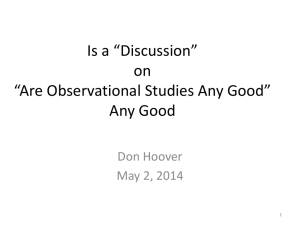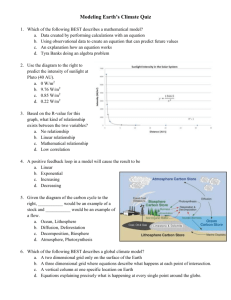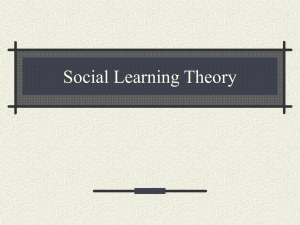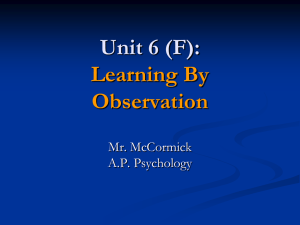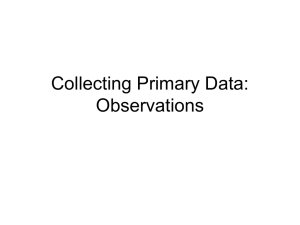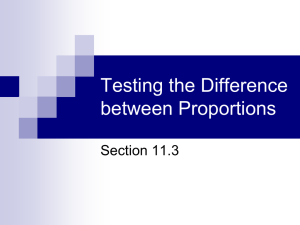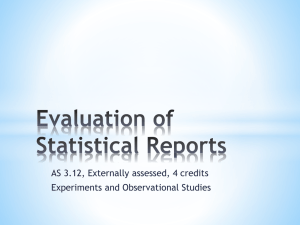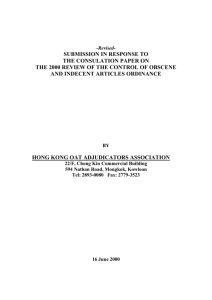Key Definitions
advertisement
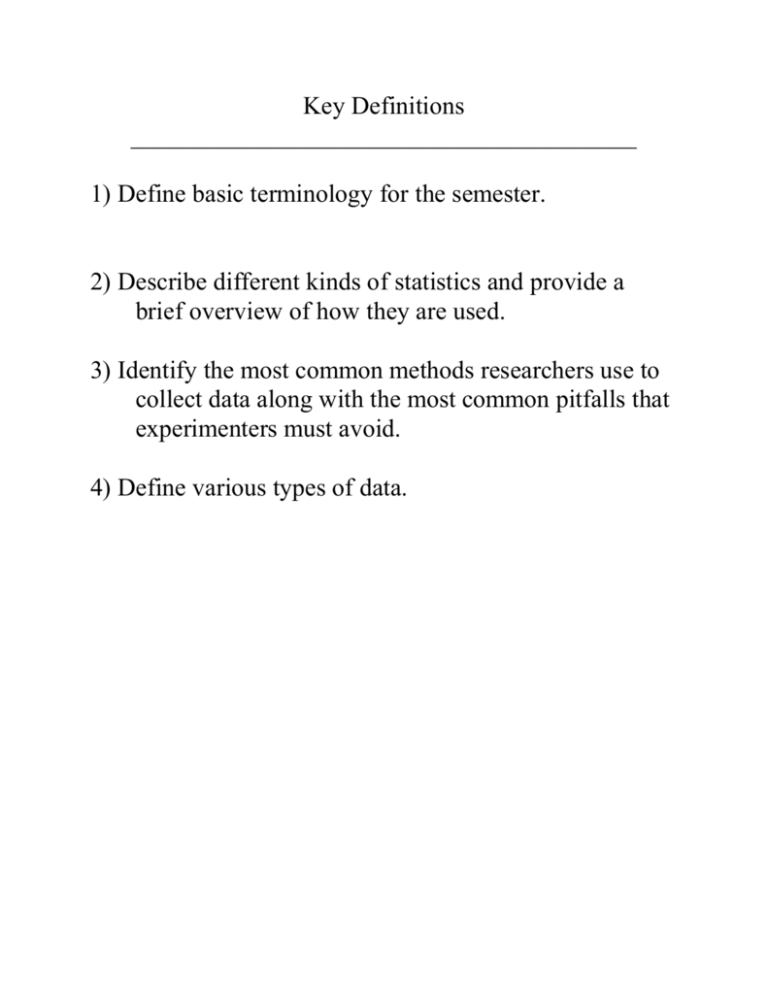
Key Definitions ________________________________________ 1) Define basic terminology for the semester. 2) Describe different kinds of statistics and provide a brief overview of how they are used. 3) Identify the most common methods researchers use to collect data along with the most common pitfalls that experimenters must avoid. 4) Define various types of data. Key Definitions ___________________________________________ STATISTIC - an estimate of some characteristic (variable) of a population based on a sample of available data STATISTICS - a set of rules, and procedures for organizing, summarizing, and interpreting data POPULATION - the entire set of people or objects that we are interested in studying CENSUS - an exhaustive collection of data from every member of the population of interest SAMPLE - a group of observations drawn from a given population; individual elements of the sample are called units VARIABLE - some characteristic of a population that we are interested in measuring. By definition, variables are free to VARY; that is, every member (unit) of the population can generate different values. More Key Definitions ___________________________________________ PARAMETER - the value of a variable for the population (derived by a census). Does not vary. STATISTIC - the value of a variable for a sample drawn from the population. Varies depending upon which members of the population are sampled. Two Different Kinds of Statistics ___________________________________________ DESCRIPTIVE STATISTICS - numerical and graphical methods for analyzing patterns within a data set; used to summarize information contained within a data set and present it to an audience. INFERENTIAL STATISTICS - the use of sample information (i.e., descriptive statistics) to make estimates, decisions, predictions and/or other generalizations about a larger set of data (i.e., the population of interest). ________________________________________ DSs allow you to a) SUMMARIZE an unwieldy set of numbers. 24% of the students in the survey smoked ISs allow you to a) draw inferences about a population b) compare two populations 24% 5% of AC students smoke More students smoke at UMass than AC How do they relate to one another? DSs are used as the basis to calculate ISs Combining DS and IS: an Overly Brief Intro ___________________________________________ You got a 70 on the first exam: Did you do better than average? Step 1 - Determine an average for the class. a) Take a census and calculate a parameter Problems? b) Take a sample and calculate a statistic You and your four friends got: 70, 80, 80, 60, 50 Mean = 68 (that's a DS) Compare 70 and 68. You did better than the average of the SAMPLE. To know if you did better than the average of the population, you need to calculate an IS. IS takes into account not only the magnitude of the statistic, but its variability as well. What if everyone in the class scored 68, except for one person who scored a 66? What if everyone in the class scored in the 80s except for a few people who scored in the 20s? Statistics ain’t perfect ______________________________________________ The Mozart effect – college students who listened to Mozart performed better than those who did not on a complex mental paper-folding task. Problem #1: People have kind of run wild with these results Municipal governments used tax money to purchase CDs for at-risk kids Other capitalists entered the fray http://www.mozarteffect.com/ http://www.howtolearn.com/Mozart.html Problem #2: Even the original result has not replicated http://skepdic.com/mozart.html Problem #3: Casts doubt on legitimate research findings http://www.psychologicalscience.org/pdf/ps/musiciq.pdf Data Collection Methods ___________________________________________ Observational Methods Look out into the world and see if two variables tend to co-exist. Methods: a) Questionnaires/self-report b) Case Studies c) Naturalistic Observations Experimental Method (Quasi-Experimental) Isolate the effects of one variable by holding all other variables constant. Methods: a) Designed studies Differences: Observational method: key variables are all measured Experimental method: some variables are measured, some are set by the experimenter (nature). As a result, the experimental method allows the researcher to draw cause and effect relationships. Comparing the Observational and Experimental Methods ___________________________________________ Does eating oat bran reduce heart disease? Observational method: Find 20 people that eat oat bran and 20 people that don't eat oat bran. See how many in each group die within some time period. Experimental Method: Find 40 people matched for age, health, etc. RANDOMLY assign people to two groups. One group eats lots of oat bran, the other does not. See how many people in each group die within some period. ______________________________________________ Questions: 1. Why can we not draw a cause-and-effect inference based on the observational study? 2. Can we ever be sure that two groups are exactly the same except for a single variable? Keys to the Experimental Method ___________________________________________ Random assignment It's the only way to ensure that all other variables are as equal as possible. Remember, with quasiexperimental at least one key IV is out of the experimenter's control. Elimination of CONFOUNDING variables What if non-oat-bran eaters smoke, but oat-braneaters do not? Comparing HC and AC students: you measure HC students coming out of Intro Psych, and AC students leaving Organic Chem? o Real world Example: TOT Setting up an Experiment: Key Terms ___________________________________________ Independent Variable (IV) the quality of interest that is more or less fixed by either the researcher or nature. Free to vary across groups but not within groups. EX: Gender college affiliation drug dosage Dependent Variable (DV) the experimental variable of interest that is believed to depend on the magnitude of the associated independent variable. Not assigned by the experimenter. EX: intelligence post-graduation success remission of illness Operational Definition - the way a researcher chooses to define the key constructs (variables) in an experiment. EX: IQ test score Salary 5 years post-graduation patient report Designing an Experiment ______________________________________________ Design an experiment to answer the following question: does exercise reduce stress? Questions: Is your experiment observational or experimental? What is/are your independent variable(s)? What is are your dependent variable(s)? What was the operational definition for each IV/DV? What are some potential confounding variables? Important Sampling Issues ___________________________________________ Randomness in a perfectly random sample, every unit in the population has the same probability of being selected. An ideal that is rarely obtained. Reliability the degree of uncertainty about some measurement; not the same as accuracy Representativeness the degree to which the sample captures important characteristics of the population; representativeness affects reliability Size in general, the larger the sample, the more representative it will be and the more reliable it will be. Sampling Errors ___________________________________________ Response Bias wording of the question affects the response Selection Bias although a quasi-random sampling method is undertaken, some important segment of the population is not represented Non-response Bias some people refuse or are unavailable to respond Types of Data ___________________________________________ a) Discrete vs. Continuous b) Qualitative vs. Quantitative Scales of Measurement Nominal a set of measurement labels that fall into different categories with no numerical relations EX: Political Party, Gender, Jersey #, Class Ordinal a set of categories that can be ordered along some dimension of size or magnitude EX: Preference Ratings Interval ordinal + the intervals between categories are identical; allows for addition and subtraction EX: Temperature (C, F) Ratio interval + an absolute 0 point which corresponds to the absence of the measured quantity; allows for multiplication and division EX: Height, Weight, Temperature (K) Who are you gonna call…a Statistician? ___________________________________________ 1) What team won the most games in the NFL last year? 2) Who hit the most home runs in a single baseball season? 3) How many people watched the last episode of Survivor? 4) How much does a senior citizen have to pay to see a movie in Amherst, MA? 5) What is the per capita income in Hampden County? 6) How does the per capita income in Hampden County compare with that in Aspen, CO? ___________________________________________ When do you need a statistician?
